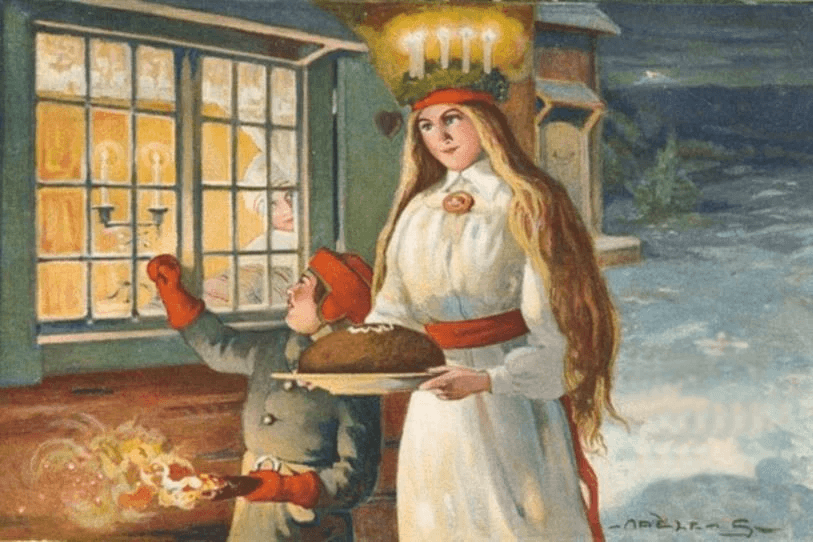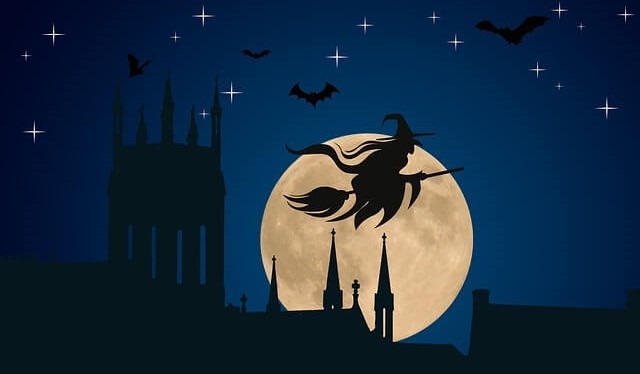cover image: www.itshungarian.com
First of all, it is really important to talk about Saint Lucy herself. Saint Lucy, or Santa / Sankta Lucia is a martyr from the 4th century, who lived in Sicily and is considered to be the town’s patron (among many other Italian towns as well). Lucy lived in a wealthy family and vowed to remain a virgin, after her mother had seen St Agatha in a dream and had miraculously been cured from an illness. However, an angry pagan suitor found her decision to dedicate herself to God unacceptable and reported her to the governor. She was sentenced to death by fire, but the fire did not affect her, and therefore, she got stabbed in the neck. Her execution took place on December 13th. This is also the day of the Winter Solstice, the shortest day of the year, and Lucy’s name, which means light, can be linked to it as the one bringing light after the long dark hours.

Celebrations in other countries
As Saint Lucy was from Sicily, we should take a look at how Italians celebrate this day. One of the most interesting facts about this celebration is that it is similar to the Saint Nicholas tradition for little children around the Northern Italian regions. She brings them little gifts during the night, arriving on a donkey and being accompanied by her escort, Castaldo. However, children are not supposed to see her delivering those gifts, as if this happens, she will throw ashes into their eyes, blinding them for a short time.
Saint Lucy’s day is also celebrated in Scandinavian countries, mostly in Sweden and Norway. During the celebration, the eldest daughter of the family wears a white robe, and has an evergreen wreath crown on her head, which is studded with candles. While in Sweden usually teenagers are the ones participating in these ceremonies, there are mostly kindergarten or primary school children in Norway. One of the examples for this tradition can be seen in the series Young Royals, with the Santa Lucia song being sung in the background.

Hungarian traditions
In Hungary, this day is also celebrated, but the traditions linked to it are quite different. To begin with, we call this day Luca day (Luca is the Hungarian version of Lucy and Lucia). Moreover, witches play a big part in the beliefs linked to this day. For this reason, women are not allowed to sew or cook during the day, for fear that witches would steal them away, and bring bad fortune for the next year. There is also a saying that the weather on this day would predict the weather for January, the next day for February and so on. The 12 days until Christmas are thought to predict the weather for the whole next year.
Another tradition is planting wheat on December 13th, which should grow out by the time of Christmas. It was done to wish upon a rich harvest for the next year. I usually used to make this at my grandmothers’ and on Christmas day we would put this grown out wheat close to the Christmas tree or next to the nativity installation.

Similarly to Norway, Hungarian kindergarten children are the ones going to different places, singing the Luca song, and bringing hay with themselves. Hungarians call it ‘lucázás’ (which is technically the verbal form of the name Luca). This tradition can be linked to the late days, when young boys used to go around, asking to be let in and tell blessings to the family. If they were let in, they knelt on hay, and said good blessings and wished for a successful harvest for the next year. After that they were given gifts from the family. However, if they were rejected, they would curse the house and bring bad luck upon the family. While growing up, I also participated in this activity, and knew the Luca song. But the thing I most vividly remember is the kindergarten children coming to my primary school, and leaving all the hay on the ground afterwards.
And lastly, let’s talk about the Luca chair! Men have to start making this on December 13th, and should finish it by Christmas, in the next 12 days. The chair is made of seven different parts, each part being a different kind of wood. A grown man should be able to stand on it in the end, and they have to get it into the midnight mass carefully hiding it from the women. If they are successful, they have to stand on it and according to the belief they can see the witches among the women. After that they have to get away and burn the chair, during which it is believed that the screams of witches can be heard.






